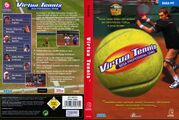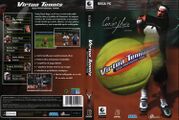Difference between revisions of "Virtua Tennis"
From Sega Retro
| Line 5: | Line 5: | ||
| publisher=[[Sega]], {{PC}} [[Empire Interactive]] (EU), [[Activision]] (US) | | publisher=[[Sega]], {{PC}} [[Empire Interactive]] (EU), [[Activision]] (US) | ||
| developer=[[Sega AM3]], {{DC}} [[Hitmaker]] | | developer=[[Sega AM3]], {{DC}} [[Hitmaker]] | ||
| − | | system=[[Sega NAOMI]], [[Sega NAOMI GD-ROM]], [[Sega Dreamcast]], Windows PC | + | | system=[[Sega NAOMI]], [[Sega NAOMI GD-ROM]], [[Sega Dreamcast]], Windows PC |
| romsize= | | romsize= | ||
| sounddriver= | | sounddriver= | ||
| Line 36: | Line 36: | ||
| sell=tp | | sell=tp | ||
}} | }} | ||
| − | '''''Virtua Tennis''''', called '''''PowerSmash''''' (パワースマッシュ) in Japan, is an arcade game developed by [[Sega AM3]] for the [[Sega NAOMI]] arcade board, as either a ROM board or a [[GD-ROM]]. It is a tennis game where the user can play as a number of real-life professional tennis players of the era competing in a number of real tournaments. Initially released in 1999, it was ported to the [[Sega Dreamcast]] in 2000, and Microsoft Windows | + | '''''Virtua Tennis''''', called '''''PowerSmash''''' (パワースマッシュ) in Japan, is an arcade game developed by [[Sega AM3]] for the [[Sega NAOMI]] arcade board, as either a ROM board or a [[GD-ROM]]. It is a tennis game where the user can play as a number of real-life professional tennis players of the era competing in a number of real tournaments. Initially released in 1999, it was ported to the [[Sega Dreamcast]] in 2000, and Microsoft Windows in 2002. |
At the time of release it was widely regarded as the most realistic tennis simulator ever produced, and received very positive reviews from critics. It has since been followed by a number of sequels, starting with ''[[Virtua Tennis 2]]'' in 2001 and ending with the recently released ''[[Virtua Tennis 2009]]''. | At the time of release it was widely regarded as the most realistic tennis simulator ever produced, and received very positive reviews from critics. It has since been followed by a number of sequels, starting with ''[[Virtua Tennis 2]]'' in 2001 and ending with the recently released ''[[Virtua Tennis 2009]]''. | ||
| − | The Dreamcast version is compatible with the [[Dreamcast Fishing Controller]]. | + | The Dreamcast version is compatible with the [[Dreamcast Fishing Controller]]. The [[Virtua Tennis (Game Boy Advance)|Game Boy Advance]] and [[Virtua Tennis (N-Gage)|N-Gage versions]] of '''Virtua Tennis'' are different games. |
==Production Credits== | ==Production Credits== | ||
Revision as of 07:04, 20 October 2013
| Virtua Tennis | |||||||||||||
|---|---|---|---|---|---|---|---|---|---|---|---|---|---|
| System(s): Sega NAOMI, Sega NAOMI GD-ROM, Sega Dreamcast, Windows PC | |||||||||||||
| Publisher: Sega, Empire Interactive (EU), Activision (US) | |||||||||||||
| Developer: Sega AM3, Hitmaker | |||||||||||||
| Genre: Sports | |||||||||||||
| |||||||||||||
|
DJCTQ
Missing Parameter! |
Virtua Tennis, called PowerSmash (パワースマッシュ) in Japan, is an arcade game developed by Sega AM3 for the Sega NAOMI arcade board, as either a ROM board or a GD-ROM. It is a tennis game where the user can play as a number of real-life professional tennis players of the era competing in a number of real tournaments. Initially released in 1999, it was ported to the Sega Dreamcast in 2000, and Microsoft Windows in 2002.
At the time of release it was widely regarded as the most realistic tennis simulator ever produced, and received very positive reviews from critics. It has since been followed by a number of sequels, starting with Virtua Tennis 2 in 2001 and ending with the recently released Virtua Tennis 2009.
The Dreamcast version is compatible with the Dreamcast Fishing Controller. The Game Boy Advance and N-Gage versions of 'Virtua Tennis are different games.
Contents
Production Credits
Dreamcast Version
Producer: Mie Kumagai
Director: Katsumoto Tatsukawa
Chief Programmer: Mitsuharu Saikawa
Programmers: Kazuyuki Kawanuma, Masayuki Inoue, Takeshi Numazawa
Chief Designer: Kazuko Noguchi
Designers: Takahiro Kajimoto, Harumi Azuma, Kenji Shimizu, Yasuhito Tanaka, Akira Fujiki, Yuko Nishimura
Sound Producer: Chiho Kobayashi
Publicity: Shintaro Takaya
Assistant Director: Masaru Futaki
Localization Team (SOJ): Shinobu Shindo, Kaoru Ichigozaki, Luke Valentine
Technical Advisor: Hans van Veenendaal
Executive Producer: Hisao Oguchi
SOE Product Development: Naohiko Hoshino, Matt O'Driscoll, Akiko Koutstaal, Roberto Parraga-Sanchez, Angelika Michitsch, Dave Thompson
SOE Thanks: Jim Pride, Mat Quaeck
Special Thanks: Fujifilm, Opel, Bridgestone, Yonex, Citizen, evian, weider, Tennis Monthly Magazine, Tennis Goods Nobu, Head, Philips, Dunlop, Babolat, IBM, Volvo
Presented by: Sega
Translated by: Hitmaker
© Sega Enterprises, Ltd., 1999, 2000
~Other credits~
SOA Product Development: Joseph Edwards, June Honma, Pedro Ponce, Michael Rhinehart, Osamu Shibamiya
SOA Marketing: John Golden, Heather Hawkins, Stacey Kerr
Physical Scans
Naomi Version
| Sega Retro Average | ||||
|---|---|---|---|---|
|
| N/A | |
|---|---|
| Based on 0 reviews | |
| 89 | |
|---|---|
| Based on 35 reviews | |
Dreamcast Version
| Dreamcast, US (Sega All Stars) |
|---|
PC Version
| PC, UK |
|---|
|
| PC, UK (Xplosiv) |
|---|
| PC, FR |
|---|
|
N-Gage Version
External Links
| Games in the Virtua Tennis Series | |
|---|---|
| Virtua Tennis (1999) | Virtua Tennis 2 (2001) | Virtua Tennis 3 (2006) | Virtua Tennis 4 (2011) | |
| Virtua Tennis (2000) | Virtua Tennis 2 (2001) | |
| Virtua Tennis (2002) | Virtua Tennis 3 (2007) | Virtua Tennis 2009 (2009) | Virtua Tennis 4 (2011) | |
| Virtua Tennis 2 (2002) | |
| Virtua Tennis (2002) | |
| Virtua Tennis (2003) | |
| Virtua Tennis: World Tour (2005) | Virtua Tennis 3 (2007) | |
| Virtua Tennis 3 (2007) | Virtua Tennis 2009 (2009) | Virtua Tennis 4 (2011) | |
| Virtua Tennis 2009 (2009) | Virtua Tennis 4 (2011) | |
| Virtua Tennis 4: World Tour Edition (2011) | |
| Virtua Tennis Challenge (2012) | Virtua Tennis Challenge Free (2012) | |
| Sampler Discs | |
| Power Smash Taikenban (20xx) | Power Smash 2 Taikenban (20xx) | |
- ↑ 576 Konzol, "December 2000" (HU; 2000-xx-xx), page 42
- ↑ Ação Games, "Setembro 2000" (BR; 2000-xx-xx), page 65
- ↑ Arcade, "September 2000" (UK; 2000-08-11), page 82
- ↑ Bonus, "6/2000" (YU; 2000-08-25), page 50
- ↑ Consoles +, "Septembre 2000" (FR; 2000-0x-xx), page 66
- ↑ Computer & Video Games, "September 2000" (UK; 2000-08-16), page 98
- ↑ Dreamcast Monthly, "September 2000" (UK; 2000-08-03), page 66
- ↑ DC-UK, "September 2000" (UK; 2000-08-02), page 56
- ↑ Dreamcast: Le Magazine Officiel, "Septembre/Octobre 2000" (FR; 2000-0x-xx), page 54
- ↑ Dreamcast Magazine, "2000-38 (2000-12-01)" (JP; 2000-11-17), page 20
- ↑ Dreamcast Magazine, "No. 12" (UK; 2000-08-10), page 42
- ↑ Dorimaga, "2002-18 (2002-10-11)" (JP; 2002-09-27), page 32
- ↑ Edge, "September 2000" (UK; 2000-08-14), page 94
- ↑ Electronic Gaming Monthly, "September 2000" (US; 2000-08-08), page 156
- ↑ Entsiklopediya igr dlya Dreamcast, "Izdaniye chetvertoye, dopolnennoye" (RU; 2002-xx-xx), page 293
- ↑ Famitsu, "2000-12-01" (JP; 2000-11-17), page 33
- ↑ Fun Generation, "09/2000" (DE; 2000-08-23), page 54
- ↑ GameFan, "Volume 8, Issue 9: September 2000" (US; 2000-xx-xx), page 86
- ↑ GamePro, "September 2000" (US; 2000-0x-xx), page 114
- ↑ Game Station (UK) (+0:00)
- ↑ Gamers' Republic, "August 2000" (US; 2000-xx-xx), page 83
- ↑ Hyper, "October 2000" (AU; 2000-08-23), page 68
- ↑ Joypad, "Septembre 2000" (FR; 2000-xx-xx), page 114
- ↑ MAN!AC, "09/2000" (DE; 2000-08-02), page 52
- ↑ Mega Fun, "09/2000" (DE; 2000-08-02), page 38
- ↑ Neo Plus, "Wrzesień 2000" (PL; 2000-xx-xx), page 32
- ↑ Next Generation, "September 2000" (US; 2000-08-15), page 107
- ↑ Official Dreamcast Magazine, "October 2000" (UK; 2000-09-07), page 66
- ↑ Playmag, "Septembre 2000" (FR; 2000-xx-xx), page 102
- ↑ Play, "Listopad 2000" (PL; 2000-xx-xx), page 20
- ↑ PSX Extreme, "03/2001" (PL; 2001-0x-xx), page 39
- ↑ Power Unlimited, "Jaargang 8, Nummer 9, September 2000" (NL; 2000-0x-xx), page 50
- ↑ Sega Magazin, "September 2000" (DE; 2000-07-31), page 14
- ↑ Strana Igr, "Avgust 2000 2/2" (RU; 2000-xx-xx), page 64
- ↑ Video Games, "09/2000" (DE; 2000-08-02), page 68
















